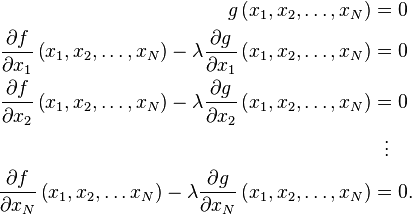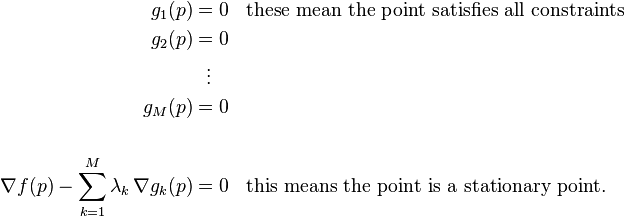Lagrange multiplier
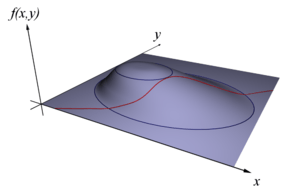
 subject to a constraint (shown in red)
subject to a constraint (shown in red)  .
.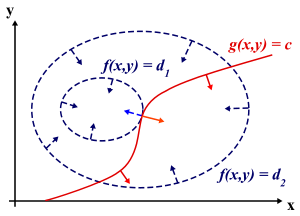
 . The blue lines are contours of
. The blue lines are contours of  . The point where the red line tangentially touches a blue contour is our solution. Since
. The point where the red line tangentially touches a blue contour is our solution. Since  , the solution is a maximization of
, the solution is a maximization of 
In mathematical optimization, the method of Lagrange multipliers (named after Joseph Louis Lagrange) is a strategy for finding the local maxima and minima of a function subject to equality constraints.
For instance (see Figure 1), consider the optimization problem
- maximize

- subject to

We need both  and
and  to have continuous first partial derivatives. We introduce a new variable (
to have continuous first partial derivatives. We introduce a new variable ( ) called a Lagrange multiplier and study the Lagrange function (or Lagrangian) defined by
) called a Lagrange multiplier and study the Lagrange function (or Lagrangian) defined by
where the  term may be either added or subtracted. If
term may be either added or subtracted. If  is a maximum of
is a maximum of  for the original constrained problem, then there exists
for the original constrained problem, then there exists  such that
such that  is a stationary point for the Lagrange function (stationary points are those points where the partial derivatives of
is a stationary point for the Lagrange function (stationary points are those points where the partial derivatives of  are zero, i.e.
are zero, i.e.  ). However, not all stationary points yield a solution of the original problem. Thus, the method of Lagrange multipliers yields a necessary condition for optimality in constrained problems.[1][2][3][4][5] Sufficient conditions for a minimum or maximum also exist.
). However, not all stationary points yield a solution of the original problem. Thus, the method of Lagrange multipliers yields a necessary condition for optimality in constrained problems.[1][2][3][4][5] Sufficient conditions for a minimum or maximum also exist.
Introduction
One of the most common problems in calculus is that of finding maxima or minima (in general, "extrema") of a function, but it is often difficult to find a closed form for the function being extremized. Such difficulties often arise when one wishes to maximize or minimize a function subject to fixed outside conditions or constraints. The method of Lagrange multipliers is a powerful tool for solving this class of problems without the need to explicitly solve the conditions and use them to eliminate extra variables.
Consider the two-dimensional problem introduced above:
- maximize

- subject to

We can visualize contours of f given by
for various values of  , and the contour of
, and the contour of  given by
given by  .
.
Suppose we walk along the contour line with  . In general the contour lines of
. In general the contour lines of  and
and  may be distinct, so following the contour line for
may be distinct, so following the contour line for  one could intersect with or cross the contour lines of
one could intersect with or cross the contour lines of  . This is equivalent to saying that while moving along the contour line for
. This is equivalent to saying that while moving along the contour line for  the value of
the value of  can vary. Only when the contour line for
can vary. Only when the contour line for  meets contour lines of
meets contour lines of  tangentially, do we not increase or decrease the value of
tangentially, do we not increase or decrease the value of  — that is, when the contour lines touch but do not cross.
— that is, when the contour lines touch but do not cross.
The contour lines of f and g touch when the tangent vectors of the contour lines are parallel. Since the gradient of a function is perpendicular to the contour lines, this is the same as saying that the gradients of f and g are parallel. Thus we want points  where
where  and
and
 ,
,
where
and
are the respective gradients. The constant  is required because although the two gradient vectors are parallel, the magnitudes of the gradient vectors are generally not equal.
is required because although the two gradient vectors are parallel, the magnitudes of the gradient vectors are generally not equal.
To incorporate these conditions into one equation, we introduce an auxiliary function
and solve
This is the method of Lagrange multipliers. Note that  implies
implies  .
.
The constrained extrema of  are critical points of the Lagrangian
are critical points of the Lagrangian  , but they are not local extrema of
, but they are not local extrema of  (see Example 2 below).
(see Example 2 below).
One may reformulate the Lagrangian as a Hamiltonian, in which case the solutions are local minima for the Hamiltonian. This is done in optimal control theory, in the form of Pontryagin's minimum principle.
The fact that solutions of the Lagrangian are not necessarily extrema also poses difficulties for numerical optimization. This can be addressed by computing the magnitude of the gradient, as the zeros of the magnitude are necessarily local minima, as illustrated in the numerical optimization example.
Handling multiple constraints


The method of Lagrange multipliers can also accommodate multiple constraints. To see how this is done, we need to reexamine the problem in a slightly different manner because the concept of “crossing” discussed above becomes rapidly unclear when we consider the types of constraints that are created when we have more than one constraint acting together.
As an example, consider a paraboloid with a constraint that is a single point (as might be created if we had 2 line constraints that intersect). The level set (i.e., contour line) clearly appears to “cross” that point and its gradient is clearly not parallel to the gradients of either of the two line constraints. Yet, it is obviously a maximum and a minimum because there is only one point on the paraboloid that meets the constraint.
While this example seems a bit odd, it is easy to understand and is representative of the sort of “effective” constraint that appears quite often when we deal with multiple constraints intersecting. Thus, we take a slightly different approach below to explain and derive the Lagrange Multipliers method with any number of constraints.
Throughout this section, the independent variables will be denoted by  and, as a group,
we will denote them as
and, as a group,
we will denote them as  . Also, the function being analyzed will be denoted
by
. Also, the function being analyzed will be denoted
by  and the constraints will be represented by the equations
and the constraints will be represented by the equations  .
.
The basic idea remains essentially the same: if we consider only the points that satisfy the constraints (i.e. are in the constraints),
then a point  is a stationary point (i.e. a point in a “flat” region) of f if
and only if the constraints at that point do not allow movement in a direction where f changes value.
is a stationary point (i.e. a point in a “flat” region) of f if
and only if the constraints at that point do not allow movement in a direction where f changes value.
Once we have located the stationary points, we need to do further tests to see if we have found a minimum, a maximum or just a stationary point that is neither.
We start by considering the level set of f at  . The set of vectors
. The set of vectors  containing the directions in which we can move and still remain in the same level set are the directions where the value of f does not change (i.e. the change equals zero). Thus, for every vector v in
containing the directions in which we can move and still remain in the same level set are the directions where the value of f does not change (i.e. the change equals zero). Thus, for every vector v in  , the following relation must hold:
, the following relation must hold:
where the notation  above means the
above means the  -component of the vector v. The equation above can be rewritten in a more compact geometric form that helps our intuition:
-component of the vector v. The equation above can be rewritten in a more compact geometric form that helps our intuition:
This makes it clear that if we are at p, then all directions from this point that do not change the value of
f must be perpendicular to  (the gradient of f at p).
(the gradient of f at p).
Now let us consider the effect of the constraints. Each constraint limits the directions that we can move from a particular point
and still satisfy the constraint. We can use the same procedure, to look for the set of vectors  containing the directions in which we can move and still satisfy the constraint. As above, for every vector
v in
containing the directions in which we can move and still satisfy the constraint. As above, for every vector
v in  , the following relation must hold:
, the following relation must hold:
From this, we see that at point p, all directions from this point that will still satisfy this constraint must be
perpendicular to  .
.
Now we are ready to refine our idea further and complete the method: a point on f is a constrained stationary point if and only if the direction that changes f violates at least one of the constraints, ie, has no "component" in the "legal" space perpendicular to  . (We can see that this is true because if a
direction that changes f did not violate any constraints, then there would be a “legal” point nearby with a higher or lower
value for f and the current point would then not be a stationary point.) Mathematically, this means that the gradient of f at this constrained stationary point is perpendicular to the space spanned by the set of vectors
. (We can see that this is true because if a
direction that changes f did not violate any constraints, then there would be a “legal” point nearby with a higher or lower
value for f and the current point would then not be a stationary point.) Mathematically, this means that the gradient of f at this constrained stationary point is perpendicular to the space spanned by the set of vectors  , which in turn is perpendicular to the gradients of the constraints g.
, which in turn is perpendicular to the gradients of the constraints g.
Single constraint revisited
For a single constraint, we use the statement above to say that at stationary points the direction that changes f is in the same direction that violates the constraint. To determine if two vectors are in the same direction, we note that if two vectors start from the same point and are “in the same direction”, then one vector can always “reach” the other by changing its length and/or flipping to point the opposite way along the same direction line. In this way, we can succinctly state that two vectors point in the same direction if and only if one of them can be multiplied by some real number such that they become equal to the other. So, for our purposes, we require that:
If we now add another simultaneous equation to guarantee that we only perform this test when we are at a point that satisfies the constraint, we end up with 2 simultaneous equations that when solved, identify all constrained stationary points:
Note that the above is a succinct way of writing the equations. Fully expanded, there are
 simultaneous equations that need to be
solved for the
simultaneous equations that need to be
solved for the
 variables which are
variables which are  and
and  :
:
Multiple constraints
For more than one constraint, the same reasoning applies. If two or more constraints are active together, each constraint contributes a direction that will violate it. Together, these “violation directions” form a “violation space”, where infinitesimal movement in any direction within the space will violate one or more constraints. Thus, to satisfy multiple constraints we can state (using this new terminology) that at the stationary points, the direction that changes f is in the “violation space” created by the constraints acting jointly.
The violation space created by the constraints consists of all points that can be reached by adding any linear combination of violation direction vectors—in other words, all the points that are “reachable” when we use the individual violation directions as the basis of the space. Thus, we can succinctly state that v is in the space defined
by  if and only if there exists a set of “multipliers”
if and only if there exists a set of “multipliers”  such that:
such that:
which for our purposes, translates to stating that the direction that changes f at p is in the “violation space” defined by the
constraints  if and only if:
if and only if:
As before, we now add simultaneous equation to guarantee that we only perform this test when we are at a point that satisfies every constraint, we end up with simultaneous equations that when solved, identify all constrained stationary points:
The method is complete now (from the standpoint of solving the problem of finding stationary points) but as mathematicians delight in
doing, these equations can be further condensed into an even more elegant and succinct form. Lagrange must have cleverly noticed that
the equations above look like partial derivatives of some larger scalar function L that takes all the
 and all the
and all the  as inputs. Next, he might then have noticed that setting every equation equal to zero is exactly what one would have to do to solve for the unconstrained
stationary points of that larger function. Finally, he showed that a larger function L with partial derivatives that are exactly the ones we require can be constructed very simply as below:
as inputs. Next, he might then have noticed that setting every equation equal to zero is exactly what one would have to do to solve for the unconstrained
stationary points of that larger function. Finally, he showed that a larger function L with partial derivatives that are exactly the ones we require can be constructed very simply as below:
Solving the equation above for its unconstrained stationary points generates exactly the same stationary points as solving for the
constrained stationary points of f under the constraints  .
.
In Lagrange’s honor, the function above is called a Lagrangian, the scalars
 are called Lagrange Multipliers and this optimization method itself is called The Method of Lagrange Multipliers.
are called Lagrange Multipliers and this optimization method itself is called The Method of Lagrange Multipliers.
The method of Lagrange multipliers is generalized by the Karush–Kuhn–Tucker conditions, which can also take into account inequality constraints of the form h(x) ≤ c.
Interpretation of the Lagrange multipliers
Often the Lagrange multipliers have an interpretation as some quantity of interest. For example, if the Lagrangian expression is
then
So, λk is the rate of change of the quantity being optimized as a function of the constraint variable.
As examples, in Lagrangian mechanics the equations of motion are derived by finding stationary points of the action, the time integral of the difference between kinetic and potential energy. Thus, the force on a particle due to a scalar potential,  , can be interpreted as a Lagrange multiplier determining the change in action (transfer of potential to kinetic energy) following a variation in the particle's constrained trajectory.
In control theory this is formulated instead as costate equations.
, can be interpreted as a Lagrange multiplier determining the change in action (transfer of potential to kinetic energy) following a variation in the particle's constrained trajectory.
In control theory this is formulated instead as costate equations.
Moreover, by the envelope theorem the optimal value of a Lagrange multiplier has an interpretation as the marginal effect of the corresponding constraint constant upon the optimal attainable value of the original objective function: if we denote values at the optimum with an asterisk, then it can be shown that
For example, in economics the optimal profit to a player is calculated subject to a constrained space of actions, where a Lagrange multiplier is the change in the optimal value of the objective function (profit) due to the relaxation of a given constraint (e.g. through a change in income); in such a context  is the marginal cost of the constraint, and is referred to as the shadow price.
is the marginal cost of the constraint, and is referred to as the shadow price.
Sufficient conditions
Sufficient conditions for a constrained local maximum or minimum can be stated in terms of a sequence of principal minors (determinants of upper-left-justified sub-matrices) of the bordered Hessian matrix of second derivatives of the Lagrangian expression.[6]
Examples
Example 1

Suppose we wish to maximize  subject to the constraint
subject to the constraint  . The feasible set is the unit circle, and the level sets of f are diagonal lines (with slope -1), so we can see graphically that the maximum occurs at
. The feasible set is the unit circle, and the level sets of f are diagonal lines (with slope -1), so we can see graphically that the maximum occurs at  , and that the minimum occurs at
, and that the minimum occurs at  .
.
Using the method of Lagrange multipliers, we have  , hence
, hence
 .
.
Setting the gradient  yields the system of equations
yields the system of equations
- Failed to parse(syntax error): \frac{\partial \Lambda}{\partial x} &= 1 + 2 \lambda x &&= 0, \\ \frac{\partial \Lambda}{\partial y} &= 1 + 2 \lambda y &&= 0, \\ \frac{\partial \Lambda}{\partial \lambda} &= x^2 + y^2 - 1 &&= 0,
where the last equation is the original constraint.
The first two equations yield  and
and  , where
, where  . Substituting into the last equation yields
. Substituting into the last equation yields  , so
, so  , which implies that the stationary points are
, which implies that the stationary points are  and
and  . Evaluating the objective function f at these points yields
. Evaluating the objective function f at these points yields
thus the maximum is  , which is attained at
, which is attained at  , and the minimum is
, and the minimum is  , which is attained at
, which is attained at  .
.
Example 2
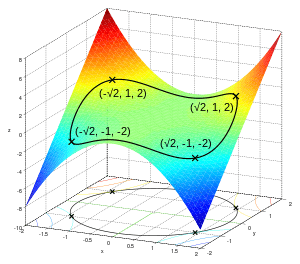
Suppose we want to find the maximum values of
with the condition that the x and y coordinates lie on the circle around the origin with radius √3, that is, subject to the constraint
As there is just a single constraint, we will use only one multiplier, say λ.
The constraint g(x, y)-3 is identically zero on the circle of radius √3. So any multiple of g(x, y)-3 may be added to f(x, y) leaving f(x, y) unchanged in the region of interest (above the circle where our original constraint is satisfied). Let
The critical values of  occur where its gradient is zero. The partial derivatives are
occur where its gradient is zero. The partial derivatives are
Equation (iii) is just the original constraint. Equation (i) implies  or λ = −y. In the first case, if x = 0 then we must have
or λ = −y. In the first case, if x = 0 then we must have  by (iii) and then by (ii) λ = 0. In the second case, if λ = −y and substituting into equation (ii) we have that,
by (iii) and then by (ii) λ = 0. In the second case, if λ = −y and substituting into equation (ii) we have that,
Then x2 = 2y2. Substituting into equation (iii) and solving for y gives this value of y:
Thus there are six critical points:
Evaluating the objective at these points, we find that
Therefore, the objective function attains the global maximum (subject to the constraints) at  and the global minimum at
and the global minimum at  The point
The point  is a local minimum and
is a local minimum and  is a local maximum, as may be determined by consideration of the Hessian matrix of
is a local maximum, as may be determined by consideration of the Hessian matrix of  .
.
Note that while  is a critical point of
is a critical point of  , it is not a local extremum. We have
, it is not a local extremum. We have  . Given any neighborhood of
. Given any neighborhood of  , we can choose a small positive
, we can choose a small positive  and a small
and a small  of either sign to get
of either sign to get  values both greater and less than
values both greater and less than  .
.
Example 3: Entropy
Suppose we wish to find the discrete probability distribution on the points  with maximal information entropy. This is the same as saying that we wish to find the least biased probability distribution on the points
with maximal information entropy. This is the same as saying that we wish to find the least biased probability distribution on the points  . In other words, we wish to maximize the Shannon entropy equation:
. In other words, we wish to maximize the Shannon entropy equation:
For this to be a probability distribution the sum of the probabilities  at each point
at each point  must equal 1, so our constraint is
must equal 1, so our constraint is  = 1:
= 1:
We use Lagrange multipliers to find the point of maximum entropy,  , across all discrete probability distributions
, across all discrete probability distributions  on
on  . We require that:
. We require that:
which gives a system of n equations,  , such that:
, such that:
Carrying out the differentiation of these n equations, we get
This shows that all  are equal (because they depend on λ only).
By using the constraint ∑j pj = 1, we find
are equal (because they depend on λ only).
By using the constraint ∑j pj = 1, we find
Hence, the uniform distribution is the distribution with the greatest entropy, among distributions on n points.
Example 4: numerical optimization
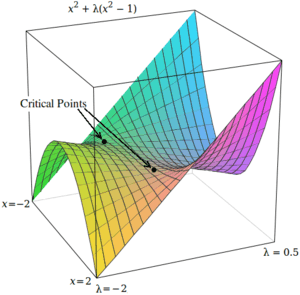

The critical points of Lagrangians occur at saddle points, rather than at local maxima (or minima). Unfortunately, many numerical optimization techniques, such as hill climbing, gradient descent, some of the quasi-Newton methods, among others, are designed to find local maxima (or minima) and not saddle points. For this reason, one must either modify the formulation to ensure that it's a minimization problem (for example, by extremizing the square of the gradient of the Lagrangian as below), or else use an optimization technique that finds stationary points (such as Newton's method without an extremum seeking line search) and not necessarily extrema.
As a simple example, consider the problem of finding the value of  that minimizes
that minimizes  , constrained such that
, constrained such that  . (This problem is somewhat pathological because there are only two values that satisfy this constraint, but it is useful for illustration purposes because the corresponding unconstrained function can be visualized in three dimensions.)
. (This problem is somewhat pathological because there are only two values that satisfy this constraint, but it is useful for illustration purposes because the corresponding unconstrained function can be visualized in three dimensions.)
Using Lagrange multipliers, this problem can be converted into an unconstrained optimization problem:
The two critical points occur at saddle points where  and
and  .
.
In order to solve this problem with a numerical optimization technique, we must first transform this problem such that the critical points occur at local minima. This is done by computing the magnitude of the gradient of the unconstrained optimization problem.
First, we compute the partial derivative of the unconstrained problem with respect to each variable:
If the target function is not easily differentiable, the differential with respect to each variable can be approximated as
 ,
,
 ,
,
where  is a small value.
is a small value.
Next, we compute the magnitude of the gradient, which is the square root of the sum of the squares of the partial derivatives:
(Since magnitude is always non-negative, optimizing over the squared-magnitude is equivalent to optimizing over the magnitude. Thus, the ``square root" may be omitted from these equations with no expected difference in the results of optimization.)
The critical points of  occur at
occur at  and
and  , just as in
, just as in  . Unlike the critical points in
. Unlike the critical points in  , however, the critical points in
, however, the critical points in  occur at local minima, so numerical optimization techniques can be used to find them.
occur at local minima, so numerical optimization techniques can be used to find them.
Applications
Economics
Constrained optimization plays a central role in economics. For example, the choice problem for a consumer is represented as one of maximizing a utility function subject to a budget constraint. The Lagrange multiplier has an economic interpretation as the shadow price associated with the constraint, in this example the marginal utility of income. Other examples include profit maximization for a firm, along with various macroeconomic applications.
Control theory
In optimal control theory, the Lagrange multipliers are interpreted as costate variables, and Lagrange multipliers are reformulated as the minimization of the Hamiltonian, in Pontryagin's minimum principle.
See also
- Duality
- Karush–Kuhn–Tucker conditions: generalization of the method of Lagrange multipliers.
- Lagrange multipliers on Banach spaces: another generalization of the method of Lagrange multipliers.
- Lagrangian relaxation
References
- ↑ Bertsekas, Dimitri P. (1999). Nonlinear Programming (Second ed.). Cambridge, MA.: Athena Scientific. ISBN 1-886529-00-0.
- ↑ Vapnyarskii, I.B. (2001), "Lagrange multipliers", in Hazewinkel, Michiel, Encyclopedia of Mathematics, Springer, ISBN 978-1-55608-010-4.
- ↑
- Lasdon, Leon S. (1970). Optimization theory for large systems. Macmillan series in operations research. New York: The Macmillan Company. pp. xi+523. MR 337317.
- Lasdon, Leon S. (2002). Optimization theory for large systems (reprint of the 1970 Macmillan ed.). Mineola, New York: Dover Publications, Inc. pp. xiii+523. MR 1888251.
- ↑ Hiriart-Urruty, Jean-Baptiste; Lemaréchal, Claude (1993). "XII Abstract duality for practitioners". Convex analysis and minimization algorithms, Volume II: Advanced theory and bundle methods. Grundlehren der Mathematischen Wissenschaften [Fundamental Principles of Mathematical Sciences] 306. Berlin: Springer-Verlag. pp. 136–193 (and Bibliographical comments on pp. 334–335). ISBN 3-540-56852-2. MR 1295240.
- ↑ Lemaréchal, Claude (2001). "Lagrangian relaxation". In Michael Jünger and Denis Naddef. Computational combinatorial optimization: Papers from the Spring School held in Schloß Dagstuhl, May 15–19, 2000. Lecture Notes in Computer Science 2241. Berlin: Springer-Verlag. pp. 112–156. doi:10.1007/3-540-45586-8_4. ISBN 3-540-42877-1. MR 1900016.
- ↑ Chiang, Alpha C., Fundamental Methods of Mathematical Economics, McGraw-Hill, third edition, 1984: p. 386.
External links
| The Wikibook Calculus optimization methods has a page on the topic of: Lagrange multipliers |
Exposition
- Conceptual introduction (plus a brief discussion of Lagrange multipliers in the calculus of variations as used in physics)
- Lagrange Multipliers for Quadratic Forms With Linear Constraints by Kenneth H. Carpenter
For additional text and interactive applets
- Simple explanation with an example of governments using taxes as Lagrange multipliers
- Lagrange Multipliers without Permanent Scarring Explanation with focus on the intuition by Dan Klein
- Applet
- Video Lecture of Lagrange Multipliers
- MIT Video Lecture on Lagrange Multipliers
- Slides accompanying Bertsekas's nonlinear optimization text, with details on Lagrange multipliers (lectures 11 and 12)
- Method of Lagrange multipliers with complex variables by kipid
- Geometric idea behind Lagrange multipliers






![{\begin{matrix}\underbrace {{\begin{matrix}\left[{\begin{matrix}{\frac {\partial f}{\partial x_{{1}}}}&{\frac {\partial f}{\partial x_{{2}}}}&...&{\frac {\partial f}{\partial x_{{N}}}}\end{matrix}}\right]\\{}\\\end{matrix}}}_{{\nabla f^{T}}}&\underbrace {{\begin{matrix}\left[{\begin{matrix}v_{{x_{{1}}}}\\v_{{x_{{2}}}}\\\vdots \\v_{{x_{{N}}}}\\\end{matrix}}\right]\\{}\\\end{matrix}}}_{{v}}&=\,\,0\\\end{matrix}}\,\,\,\,\,\,\,\,\,\,\,\,{\text{is the same as writing}}\,\,\,\,\,\,\,\,\nabla f^{T}\,\,\,\centerdot \,\,\,\,v\,\,=\,\,\,0.](/2014-wikipedia_en_all_02_2014/I/media/c/d/2/3/cd23cd67a00ddb1f25fbb709a8065080.png)



